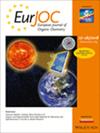卤代二烯与NHCs的反应:低价Ge(II)的选择性形成
IF 2.5
3区 化学
Q2 CHEMISTRY, ORGANIC
引用次数: 0
摘要
基于Rind的1,2 -二卤二烯,(Eind)BrGe=GeBr(Eind) (1a)和(EMind)ClGe=GeCl(EMind) (1b),与两种N -杂环碳烯(Im‐iPr2Me2和Im‐Me4)反应生成卤代二甲苯单NHC加合物(Im‐iPr2Me2)(Eind)GeBr (2a‘)和(Im‐iPr2Me2)(EMind)GeCl (2b’),以及菌基甲基双NHC加合物[(Im‐Me4)2(Eind)Ge]+[Br -] (3a)和[(Im‐Me4)2(EMind)Ge]+[Cl -] (3b)。通过单晶X射线衍射(SC - XRD)分析证实,得到的Ge(II)物质被较大的Rind基团和强供σ的NHC配体所稳定。通过对2a′和3a的阳离子部分的DFT和QTAIM计算,得出Ge-C (Eind)和Ge-C (NHC)键的极化程度有明显差异,但Ge-C键都表现出部分极化的共价特征。反应能计算和实验研究都表明,NHC配体可能从菌基甲基阳离子双- NHC加合物中解放出来,从而导致NHC配体的交换。基于DFT计算,讨论了1a和两个NHC分子通过(Im‐Me4)(Eind)GeBr (2a)由1a和两个NHC分子形成3a的机理。本文章由计算机程序翻译,如有差异,请以英文原文为准。
Reactions of Halogermylenes with NHCs: Selective Formation of Low Valent Ge(II) Species
The reactions of the Rind‐based 1,2‐dihalodigermenes, (Eind)BrGe=GeBr(Eind) (1a) and (EMind)ClGe=GeCl(EMind) (1b), with two types of N‐heterocyclic carbenes (NHCs) (Im‐iPr2Me2 and Im‐Me4) resulted in the formation of the halogermylene mono‐NHC adducts, (Im‐iPr2Me2)(Eind)GeBr (2a') and (Im‐iPr2Me2)(EMind)GeCl (2b'), and the germyliumylidene cation bis‐NHC adducts, [(Im‐Me4)2(Eind)Ge]+[Br–] (3a) and [(Im‐Me4)2(EMind)Ge]+[Cl–] (3b). The resulting Ge(II) species are stabilized by the bulky Rind groups and the strongly σ‐donating NHC ligands, whose structures were confirmed by a single‐crystal X‐ray diffraction (SC‐XRD) analysis. Based on DFT and QTAIM calculations of 2a' and the cationic part of 3a, it was concluded that while the Ge–C(Eind) and Ge–C(NHC) bonds exhibit distinct differences in their degrees of polarization, all the Ge–C bonds display a partially polarized covalent character. Both reaction energy calculations and experimental studies suggested the potential liberation of an NHC ligand from the germyliumylidene cation bis‐NHC adducts, leading to the exchange of the NHC ligands. The formation mechanism of 3a from 1a and two NHC molecules via (Im‐Me4)(Eind)GeBr (2a) is discussed based on DFT calculations.
求助全文
通过发布文献求助,成功后即可免费获取论文全文。
去求助
来源期刊
CiteScore
5.40
自引率
3.60%
发文量
752
审稿时长
1 months
期刊介绍:
The European Journal of Organic Chemistry (2019 ISI Impact Factor 2.889) publishes Full Papers, Communications, and Minireviews from the entire spectrum of synthetic organic, bioorganic and physical-organic chemistry. It is published on behalf of Chemistry Europe, an association of 16 European chemical societies.
The following journals have been merged to form two leading journals, the European Journal of Organic Chemistry and the European Journal of Inorganic Chemistry:
Liebigs Annalen
Bulletin des Sociétés Chimiques Belges
Bulletin de la Société Chimique de France
Gazzetta Chimica Italiana
Recueil des Travaux Chimiques des Pays-Bas
Anales de Química
Chimika Chronika
Revista Portuguesa de Química
ACH—Models in Chemistry
Polish Journal of Chemistry.

 求助内容:
求助内容: 应助结果提醒方式:
应助结果提醒方式:


